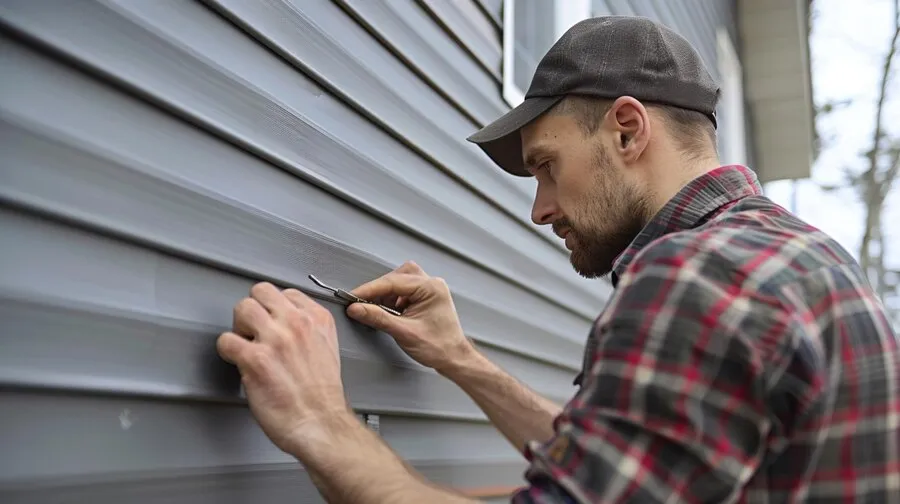Table of Contents
Siding plays a pivotal role beyond merely defining your house’s appearance. It interfaces between your cozy interior and the Rharsh elements outside. Understanding the nuanced roles that different types of siding play is essential in maintaining home durability and aesthetic value. Homeowners often need to replace siding to preserve their house’s health or update its appearance to match contemporary styles.
Many homeowners might initially find a siding replacement project overwhelming. Siding is more than just a decoration; it is a crucial shield for your house, helping it withstand storms, keep energy costs down, and provide a welcoming look. A siding replacement contractor can be a reliable service that combines durability and style. Their solutions are meticulously crafted, ensuring your home remains protected and looks appealing for years. This complete manual aims to offer homeowners vital knowledge on replacing siding. Covering everything from material options to the replacement process, this article seeks to demystify the complex decision and planning processes, ensuring that you can approach your siding replacement project with confidence and clarity.
Why Siding Matters
The siding of your home is crucial for many reasons. It shields your home’s structure from environmental hazards, provides insulation to help regulate internal temperatures, and adds to the property’s value. Effective siding helps prevent moisture infiltration, which can lead to mold growth, rot, and structural damage. Moreover, well-maintained siding can significantly enhance your home’s curb appeal, drawing admiration from neighbors and prospects if you’re considering a sale. Well-installed siding substantially reduces energy costs by improving your home’s insulation.
Types of Siding Materials
Choosing the suitable siding material requires consideration of several factors, including cost, longevity, maintenance, and environmental impact. Popular options include vinyl, which is cost-effective and low-maintenance, making it a favorite among many homeowners. Wood siding has a natural aesthetic and can be customized with various paint or stain colors, but it demands higher maintenance. On the flip side, fiber cement is praised for its ability to withstand fire, insects, and rot, making it an excellent option for lasting protection. Composite materials blend durability with low maintenance and are highly customizable. Every material has specific advantages and disadvantages based on your home’s requirements and personal taste.
Signs Your Home Needs New Siding
Visible signs like fading, warping, or even cracking could indicate the need for replacement. An unexplained hike in your energy bills might indicate compromised insulation due to aging siding. Additionally, molds, mildew, or rot should set off alarms, indicating deeper issues that could compromise the structural integrity of your home. Regular home exterior evaluation and maintenance are essential for early problem detection and effective management.
Steps to Replace Siding
The siding replacement process involves several crucial steps. Proper planning begins with accurately measuring your home to estimate the amount of siding material required. Choosing the right design and material that complements your home’s architecture is equally vital. After selecting new materials, it is essential to remove the old siding carefully to prevent harm to the sheathing and insulation below. Afterward, preparing the surface before beginning installation is necessary, which involves sealing, caulking, and possibly installing house wrap to maximize weather resistance. Finally, for optimum results and to avoid unexpected complications, it’s often advantageous to enlist professional installers with the experience and tools necessary to complete a flawless siding installation.
Benefits of Replacing Siding
Replacing your home’s siding can provide numerous benefits beyond improved appearance. New siding materials are typically more energy-efficient, which translates into heating and cooling cost savings. Additionally, renewing your siding with modern materials can immediately uplift your property value and allure, proving especially beneficial if you sell your home. New siding also offers enhanced protection against weather, pests, and everyday wear and tear, safeguarding your investment in the long run.
Also Read: How to Start a Vegetable Garden in Your Backyard
Common Mistakes to Avoid
When replacing siding, homeowners should be mindful of potential mistakes that can lead to long-term complications. One standard error is paying attention to the importance of surface preparation, which can lead to poor installation and compromised siding performance. Selecting inappropriate materials that don’t suit your climate or home style can cause increased expenses and frequent repairs. Improper installation can cause gaps, resulting in moisture buildup, mold, and damage. It’s crucial to research consummately and, if necessary, consult with professionals to ensure that the project is completed without these costly mistakes.
Expert Tips for Maintaining Your New Siding
After investing in new siding, maintaining its integrity and appearance should be a priority. Regular cleaning and inspections can help prevent dirt accumulation and catch any signs of potential damage early. Ensure your gutters and downspouts are functioning well to avoid water damage, a leading cause of siding issues. Promptly addressing minor repairs will prevent them from growing into significant problems, guaranteeing the longevity of your siding and preserving your home’s charm and value.




